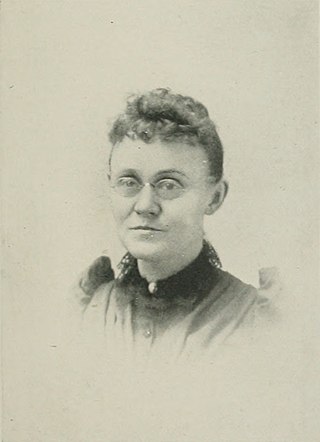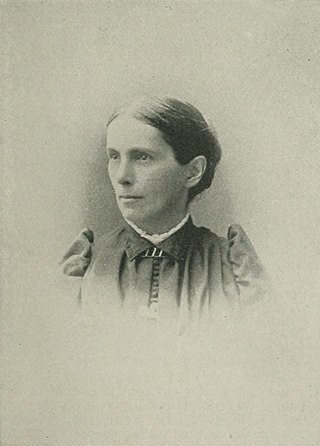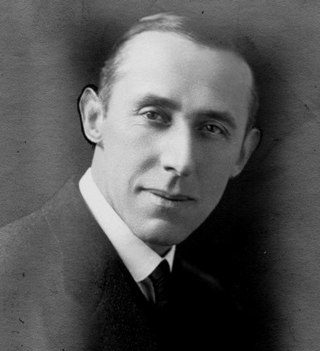Related Research Articles

James Syme was a Scottish pioneering surgeon.

Mary Hannah Gray Clarke was an American author, correspondent, and poet from Rhode Island. She wrote extensively for magazines and for the public press, and was also the author of many dramas, lyric poems, operettas, stories for the young, and essays. In addition to the operettas, "Just Like Cinderella" and "Jack Frost's Visit to the Fairies", her works included "Effle, Fairy Queen of Dolls," "Prince Pussin-Boots," "Golden Hair and her Knight of the Beanstalk in the Enchanted Forest," "Obed Owler and the Prize Writers," "How I Came to Leave Town and What Came of It," "Edith Morton, the Sensible Young Lady;" "The Story that the Willow Basket Told to Faith Fairchild;" "English Lyrics;" and "Home;" as well as a number of songs, such as "Were it not for Dreams;" ; "Twittering Swallow;" "Robin, Robin, Bold and Free;" "Down by the River;" "Not to Blame;" and "Our-Leafed Clover."

Ella M. S. Marble was an American physician who worked as a journalist, educator, and activist earlier in her career. From girlhood, she took an active interest in any movement calculated to advance the interests of women. Interested in literary and philanthropic work, Marble served as president of the District of Columbia Federation Womans' Clubs, numbering ten societies and 2,500 members ; president, District Federal; vice-president, Womans' National Press Association for state of Maine; president, Minnesota State Suffrage Association; president, Minneapolis City Suffrage Association; president, Washington City Suffrage Association; Secretary, Pro Re Noto; and secretary, White Cross Society of Minneapolis.

Euphemia Wilson Pitblado was a Scottish-born American women's activist, social reformer, and writer. She traveled in Europe, Canada, and in the United States, crossing the Atlantic five times. Pitblado was a delegate to the National Woman Suffrage Association Convention in Washington, D.C., the New England Woman's Suffrage Association Conventions, the National Woman's Christian Temperance Union (WCTU) Conventions in New York City, Denver, and Chicago, and to the annual Woman's Foreign Missionary Conventions in Boston and Lowell, Massachusetts. Her principal literary works were addresses upon temperance, suffrage, missions, education, and religion.

Ella Blaylock Atherton was a British-born American physician. Atherton was the first woman in the province of Quebec to earn a diploma in medicine from a Canadian institution. She was the first woman admitted to a medical society in the U.S. state of Vermont, the first to be president of a local medical society in New Hampshire, and the first woman to perform abdominal surgery in New Hampshire.

Jennie McCowen was an American physician, writer, and medical journal editor. She lectured on and supported woman's suffrage.

Alice Bellvadore Sams Turner was an American physician, who also taught school, and was a frequent contributor to the public press. She graduated with the Class of 1884 from the Keokuk College of Physicians and Surgeons as an allopathic doctor. Turner practised medicine in Colfax, Iowa, from March, 1884. She was a member of the Iowa State Medical Society; Iowa Public Health Association, having been the first woman admitted to membership, in 1890, of the State Library Association; Colfax Public Library Association, secretary four years, 1893–97; Chautauqua Literary and Scientific Circle; Woman's Christian Temperance Union; Woman's Relief Corps; Rathbone Sisters; and was health officer of Colfax, 1886–87.

Esther Pritchard was a 19th-century American minister and editor. Pritchard was the daughter of a minister of the Society of Friends. She was one of the leading preachers of the Friends' Society in the United States, and was the Woman's Christian Temperance Union's Superintendent of the Department of Systematic Giving. Pritchard edited for some years the Friend's Missionary Advocate, and was a teacher in the Chicago Training School for Missions. Her husband's removal from Chicago to the pastorate of the Friends church, Kokomo, Indiana, severed her connection with the school and left her free to push the special work of her department. Seventeen State Unions subsequently adopted the department, while outside the Woman's Christian Temperance Union, ten Woman's Missionary Boards were influenced to create a similar agency. She died in 1900.

Clara Cleghorn Hoffman was an American educator and temperance reformer. She became identified with the white-ribbon movement in Kansas City, Missouri, giving up her position as principal of a school to enter the work of the Woman's Christian Temperance Union (WCTU). She served as President of the Missouri WCTU for 25 years. Within the National WCTU, she lectured across the U.S, was chosen Assistant Recording Secretary, and Recording Secretary, succeeding Lillian M. N. Stevens.

Emma E. Bower was an American physician, and a newspaper owner, publisher, and editor. She was also an active clubwoman. Bower practiced medicine in Detroit, Michigan before returning to Ann Arbor, Michigan where, from 1896 to 1904, she owned, published, and edited a county paper, the Ann Arbor Democrat. For nine years, she was a member of the Ann Arbor board of education, during such time holding the office of president and treasurer. She served as treasurer of the Michigan Woman's Press Association, secretary-treasurer of the Michigan State Fraternal Congress, and held the office of president of the National Fraternal Press Association. She was the Great Record Keeper of the Ladies of the Maccabees.

William Francis Victor Bonney FRCP FRCS was a prominent British gynaecological surgeon. He was described by Geoffrey Chamberlain as "a primary influence on world gynaecology in the years between the wars".

Benjamin Fordyce Barker (1818–1891), generally known as Fordyce Baker, was an obstetrician from Maine who was a visiting physician at Bellevue Hospital from 1855 to 1879 and a consulting physician there from 1879 to his death.

Marietta Bones was an American woman suffragist, social reformer, and philanthropist. In 1881 Bones was elected vice-president of the National Woman Suffrage Association (NWSA) and annually re-elected for nine years. In 1890 suffragist Susan B. Anthony and supporters of the movement merged the National Women Suffrage Association into the National American Women Suffrage Association (NAWSA). In 1882, Bones made her first appearance as a public speaker in Webster, soon to be Webster, South Dakota, where she later resided. She was an active temperance worker, and was secretary of the first Non-Partisan National Woman's Christian Temperance Union in 1889. She took great interest in all reform and charitable institutions.

Harriet E. Garrison was an American physician and medical writer whose practice was based in Dixon, Illinois. She traveled widely and wrote on medical topics, presenting papers at medical conferences.

Susanna M. D. Fry was an American educator and temperance worker. Her teaching career began in the primary department of the village school, but her superior ability as a teacher led her swiftly into positions of greater responsibility. Fry was a professor who held the chair of English literature at Illinois Wesleyan University, Bloomington, Illinois and at the University of Minnesota. She served as president of the Minnesota Woman's Christian Temperance Union (W.C.T.U.), and managing editor of The Union Signal, the organ of the National W.C.T.U. During her career as a professor and as an official of the W.C.T.U., Fry was a frequent speaker in Prohibition campaigns and at temperance conventions. Fry was the only woman chosen from the Methodist church to speak before the Parliament of the World's Religions, 1893.
Non-Partisan National Women's Christian Temperance Union was an American temperance association organized at Cleveland, Ohio, January 22, 1890, as a protest against the attitude of the Woman's Christian Temperance Union (W.C.T.U.) toward political parties.

Eunice D. Kinney was a Canadian-born American physician who specialized in hypertrophic arthritis and neuritis. She was born and passed her early years in a log cabin in New Brunswick. Her educational opportunities were so limited that up to the age of 21, she had attended school for only two and half years. Kinney graduated from the Boston Training School for Nurses in 1881, obtained her medical degree from the College of Physicians and Surgeons, Boston, in 1890, and her post-graduate degree from Tufts College Medical School in 1895. While working as a practicing physician, she engaged to some extent in literary work, editing several nursing and medical journals, and serving as a press correspondent. Kinney was the first woman physician to testify as an expert before the U.S. circuit court.

Josephine R. Nichols was a popular American lecturer of the 19th-century, and a temperance reformer affiliated with the Woman's Christian Temperance Union (WCTU). She was also a strong advocate of woman suffrage. Her most notable accomplishments were as superintendent of the exposition department of the National WCTU, where she worked for years, beginning in 1883. In 1885, the Indiana State WCTU made her its president, but she continued her practical work for the national society, extending and illustrating information about the aims of the cause.
Wilhelmine Lohmann was a German teacher, social worker, and temperance leader who served as president of several organizations. She also wrote articles for Die Lehrerin: Organ des Allgemeinen Deutschen Lehrerinnenvereins.
Ligue de femmes Suisses contre l'alcoolisme was a women's temperance organization of Switzerland. Founded at Geneva on November 3, 1899, the headquarters were located at Rue Etienne-Dumont, 22, Geneva. A Central Committee, composed of 24 members, had charge of the affairs of the Ligue. The organization did not impose total abstinence on its members. It was broadly open to all women committed to the fight against the abuse of drink and to the resolute fight against absinthe and all distillation products. The Ligue was in constant contact with cantonal and municipal authorities. It was able to exert some influence, particularly on anti-alcohol education in schools.
References
- 1 2 3 4 5 6 7 "Obituary". British Medical Journal. Assoc: 517. 1 March 1890. Retrieved 23 July 2024.
 This article incorporates text from this source, which is in the public domain .
This article incorporates text from this source, which is in the public domain . - ↑ "XIIIb. Schweizerischer Frauenverein gegen den Alkoholismus.". Alkoholismus (in German). Vol. 1. 1904. p. 101. Retrieved 23 July 2024.
- ↑ World's Woman's Christian Temperance Union Convention (1897). "AFTERNOON, June 9th". Report of the ... Biennial Convention and Minutes of the Executive Committee Meetings of the World's Woman's Christian Temperance Union. White Ribbon Company. p. 6. Retrieved 23 July 2024.
 This article incorporates text from this source, which is in the public domain .
This article incorporates text from this source, which is in the public domain .